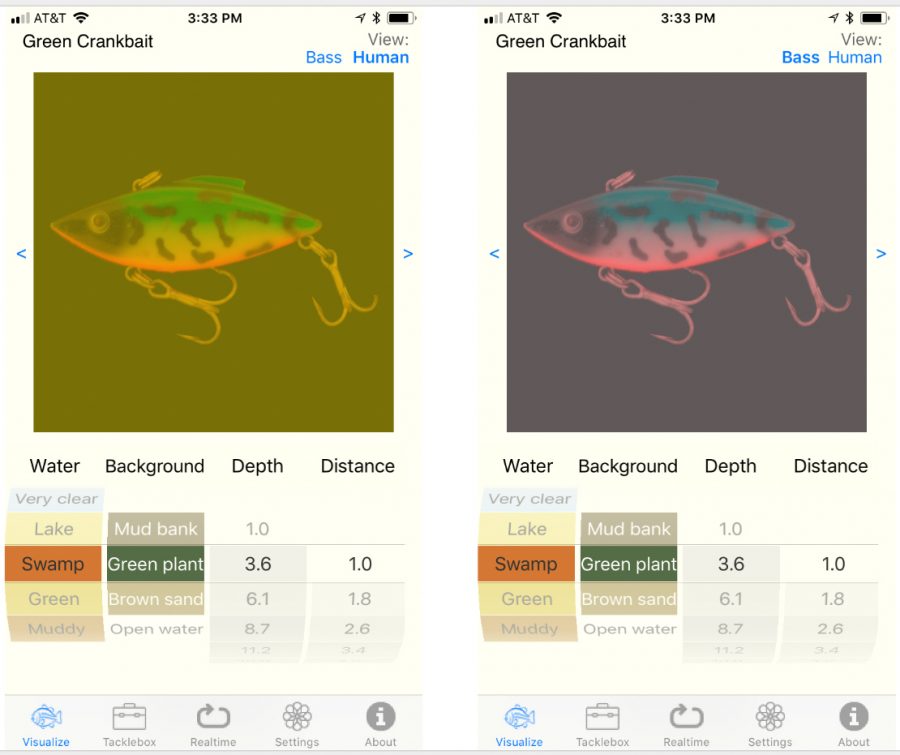New app allows users to ‘think like a fish’
Photo Courtesy of Dr. Becky Fuller
The two images display how a bass would see a lure in swamp water (on the right) versus how a human would see it in swamp water (on the left).
December 4, 2017
Imagine seeing the world through the eyes of a fish. More specifically, a largemouth bass.
The BassVision app, launched Aug. 28 users lets see how largemouth bass see lures in the water.
The app was created by Becky Fuller in the School of Integrative Biology, along with Administrative Information Technology Services at the University and her colleagues, Cody Sullivan, Cory Suski and John Epifanio with her startup company BassInSight.
The science behind the app revolves on differing types and amounts of cones in an animal’s eyes. Cone cells in the eye are responsible for color vision. Bass have only two cones in their retinas, whereas humans have three, which results in different perspectives.
Fuller got the idea for the app from studying killifish, which are small fish with varying color patterns in red, blue and yellow.
Get The Daily Illini in your inbox!
“We found these really interesting patterns where we found more blue males in swamps and more red and yellow guys in the springs,” Fuller said. “We’ve been studying this pattern for a long time, and we were interested in how their major predator might see them.”
Their major predator is the largemouth bass. When creating the vision detection model for the bass, Fuller was surprised to find there wasn’t much information on their vision system.
“There’s a multibillion dollar industry surrounding bass, and it slowly but surely dawned on us that figuring out how largemouth bass see things might be interesting, not only to scientists, but to anglers who want to pick their lures for habitat types,” Fuller said.
Dr. Cory Suski, in the School of Integrative Biology, helped with the layout, design and integrating photos into the app.
As an angler, or fisherman, Suski was also able to guide app development and provide input on the applicability for anglers.
“My experience with the app to date has been outstanding,” Suski said in an email. “It has really made me think differently about color as it relates to fishing, and has helped me to ‘think like a fish’ when I’m selecting lures.”
Fuller said the app is a good way to get young people involved in fishing.
“They (the fishing industry) have been worried that they’re losing anglers to smartphones, computers and screens, and so they’re really interested in developing technological tools and ways to get people interested in fishing again,” Fuller said.
Sullivan, part of marketing for BassInSight, said they are currently trying to integrate the apps into schools to cater toward the youth base.
“We’re still in the post development, premarketing phase,” he said. “We are getting our foot in the door from the marketing standpoint.”
Jim Caputo from Administrative Information Technology services was the lead on the project for developing the app.
He is part of the mobile development team that creates Android and IOS apps for the University.
“Mobile applications and mobile technology is where the world is headed,” Caputo said. “(The fishing industry is) just one more area I can see technology applied in a positive way.”
Suski also said he was excited to see the potential for technology use in the fishing industry.
“Our app is a new and novel use of cell phone technology, and represents a new way to both engage anglers and help people enjoy their fishing experience,” Suski said.
Editor’s Note: A previous version of this article referred to the Administrative Information Technology Services as Information Technology Services. The Daily Illini regrets this error.







